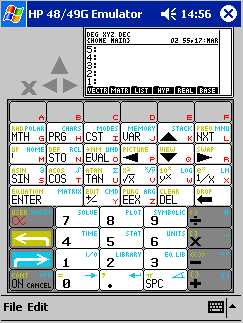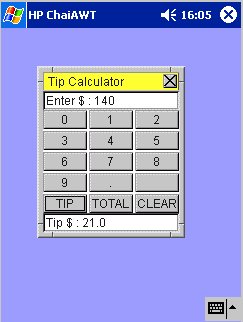 |
 |
| IE with HP-12C Emulator | Stylus entry and results |
|---|
In V21N1 I gave a broad overview of the Jornada 568. After another couple of months with the machine I thought an update would be a good idea. I've also been asked about programming Jornadas and whether an HP12C emulator is available so I'll try to answer these questions and tidy up some things from the first article.
Firstly I should mention that updates to Windows and the firmware are available to download from the HP web site:
http://www.hp.com/cposupport/swindexes/hpjornada563928_swen.html
I had the motherboard replaced to try and fix the sound problem I discussed last time but the machine came back with exactly the same fault. After loading the updates, the clicking noise had vanished (but the hiss on the right hand channel remains).
After the first article Chris Randle (#832) got in touch to say that he had managed to get Emu48 working. I had another go and this time it worked. It may have had something to do with me pressing the wrong OK button as there are two visible at the same time at one point. Even MetaKernel works fine. I'm still having trouble emulating a 1M card for ports 2 upwards. If anyone has done this please get in touch.
Does Emu48 turn the 568 into a suitable calculator replacement then? Well I think there is still some way to go. Even with a 206MHz CPU it's still only 2.4 times faster than a real HP48G at running << 1 1000 START NEXT >> and response to the stylus is pretty bad. There really is nothing to beat a decent HP keyboard. More on keyboards later.
Emu48 does allow something important though: on machine programming in RPL!
Can the 568 emulate a HP-12C? Here we have another success. I had a look at the JavaScript HP-12C emulator (linked from the HPCC web site). This only emulates part of the functionality of the HP-12C: the TVM bit so it's not complete by any means.
The original screen layout isn't exactly suitable for the PocketPC format so I've had a tweak and put a new version on the HPCC site. I've cut it down to 1 file so that you can copy it onto the 568 and keep it in a safe place rather than having to rely on Internet Explorer's cache. Then if you click on the hp12c file, the emulator starts up. See the screen dumps below. These were created using 'Remote Display Control' which is available for free download from the Microsoft PocketPC site. This tool allows you to drive your Jornada from your PC screen (and therefore capture the screen into a suitable painting package).
 |
 |
| IE with HP-12C Emulator | Stylus entry and results |
|---|
We've now got several ways to program this machine. Some of these were mentioned last time - others are new discoveries:
Of these the first two can be programmed on the machine, the last two require a PC to create suitable files. The full Java environment available from the HP site (Chai rather than Microchai) includes the ability to run Java programs that make use of the awt GUI. This looks a particularly good route to go. There is even a simple RPN calculator being coded using Java for this platform (but presumably can run on any other Java virtual machine as well).
As far as programming in JavaScript goes, once you have created an HTML file containing JavaScript and sent it to the Jornada you can use Pocket Word to edit it.
It tool me a while to figure out how to create new files on the Jornada itself. The answer lies in a piece of freeware imaginatively called "Pocket Notepad". This provides most of the functionality of Notepad on desktop Windows machines including ‘Save As’ which allows you to create text files and then save them as another type like ".html". With this you have an environment that allows on machine programming and execution using a reasonable high level language. Pocket Notepad can be found at: http://www.tillanosoft.com
I still haven't tried out some of the other options available:
No doubt there are others.
I installed the SDK, and then had to have my machine rebuilt as it ran out of disk space part way through and completely trashed itself! The Perl sounds intriguing, as does the fact that the 568 will run a web server. This I'll have to find time to try.
 |
 |
| Emu48 running HP48 ROM | Java Tip Calculator |
|---|
The shortcomings of stylus input quickly become apparent when you try programming the Jornada on the move. There are now a couple of options available. The Targus Stowaway folding keyboard unfolds to the same size as a standard keyboard so offers good feel if you have lots of space. The HP Micro Keyboard is more like one of those keyboards that clips on the bottom of a mobile phone.
The Micro Keyboard replaces the cover of the Jornada and provides 37 keys. It adds a reasonable amount of extra weight and bulk to the machine. Possibly the most amazing feature is the backlight button. I sat there looking at the screen expecting to see the backlight go on and off – but it doesn’t. The backlight button is to backlight the keys so that you can type in the dark!
With only 37 keys something has to give and unfortunately for us it’s the numeric keys. To get numbers you have to press the ‘special’ key and then use ‘qwertyuiop’ for ‘1234567890’. This makes using any maths applications a bit of a pain.
With the keyboard attached you also lose the thumb pad and quick launch keys because the keyboard physically covers them up. Also you can’t easily dock the Jornada – you have to unclip the keyboard either completely (which stresses the lugs that hold it in place at the top) or partly and leave the bottom of the keyboard hanging over the front of the docking station.
I mentioned last time that Compaq are promoting the iPAQ as a portable presentation system for road-warriors. I don’t really fit into this category but I do need to present what we’re doing on the PocketPC. Now I can with the purchase of a Colorgraphic Voyager VGA card. This allows different resolutions, numbers of colours, screen orientation and output to composite video and S-Video as well as suitable VGA monitors. It comes with a CD with drivers and links to presentation software (PowerPoint is not part of PocketPC 2002). I’ve had mixed results with the PowerPoint replacements and you have to pay for them so I guess I’ll stick with my laptop for slides. The VGA card also comes with a CF to PC card adapter so that you can use the card on other machines.
I think HP must have read my last article and burnt some midnight oil as the HP Jornada 928 has been 'leaked' to the public. It is essentially a 568 plus GSM and GPRS capability. It is rumoured to be available summer 2002 in Europe. More details can be found at: http://www.infosync.no/show.php?id=1473
I've been connecting my 568 to the Internet using a Pretec PocketPC 56K Compact Flash modem. This works fine and I've had no trouble connecting to my ISP or to the company Intranet using a SecureId system. With the acquisition of the VGA card I can’t use this modem at the same time so I’m going to try and get hold of a Psion InfraRed 56K modem. This is a small box containing the modem and an IR receiver/transmitter and connects straight into your phone socket. With this I should be able to connect to the Internet and show the results on a big screen all at the same time.
The modems, keyboard, VGA card and other accessories such as cases and CF Ethernet cards are available from: http://www.mobtech.co.uk/
After another two months with this machine, my opinions have changed quite a lot. I'm still disappointed by the MP3 playback and between them HP repair and the Royal Mail took a month to send me back the backup battery holder and battery that went missing when I had the motherboard replaced.
On the positive side, software and accessories are becoming available and unlike on desktop machines, they really are all plug and play. I've got the hang of Pocket Excel and Code Wallet to replace some tasks that my trusty HP48GX used to do pretty poorly. There is still much to explore and if Wlodek has bought a Jornada maybe we really should start taking them seriously.
| mark.power@btinternet.com | Page last modified : 3rd November 2002 |